The Standard Model Is Not Enough, New LHC Study Shows

The Universe, according to our best understanding, just doesn’t add up.
The Universe, according to our best understanding, just doesn’t add up. Wherever we look — from tiny subatomic scales all the way up to planetary, galactic, or even cosmic ones — we find that everything is overwhelmingly made of matter, rather than antimatter. We have a remarkable story of how our Universe came to be the way it is today: the hot Big Bang, as well as an understanding of how the particles that exist in our Universe behave: according to the rules of the Standard Model. But they can’t explain the Universe we know we actually inhabit.
The laws of physics, as we know them, aren’t perfectly symmetric between matter and antimatter, instead displaying subtle but important differences. These differences are:
- difficult to measure,
- small in magnitude,
- predicted by the Standard Model,
- but insufficient to explain the matter-antimatter asymmetry found in our Universe today.
In a fascinating new paper, the LHCb collaboration has made the best measurement ever of one of the key parameters needed to create a Universe filled with matter. Here’s what we’ve learned.
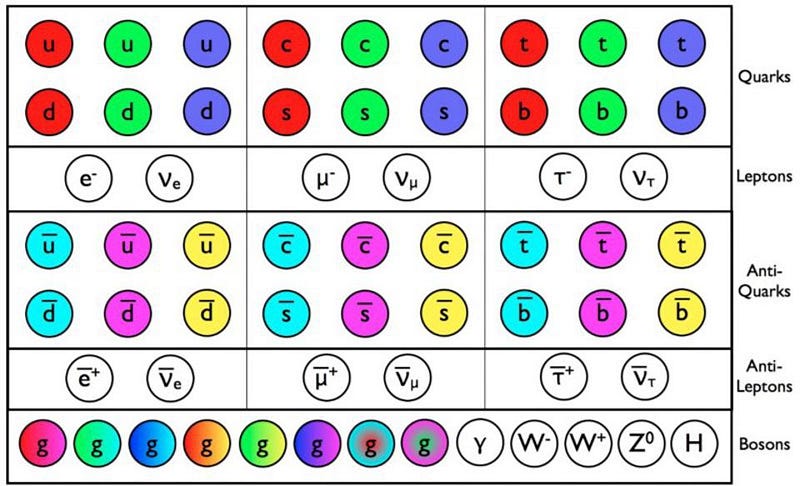
All of the particles we’ve ever directly detected fit within the Standard Model of elementary particles, with no exceptions. This includes both fermions and bosons, where the fermions includes the six quarks (up, down, strange, charm, bottom, and top) and six leptons (the electron, muon, tau, and the three neutrinos associated with them), as well as their antimatter counterparts, while the bosons include the photon, the eight gluons, the three weak-mediating bosons, and the Higgs.
The Standard Model predicts that quark-containing composite particles (such as mesons and baryons) which undergo weak decays should display an important difference between matter and antimatter. Measuring the differences that you get should tell us three important things:
- whether all of our combined observations are consistent within the same framework,
- whether these measurements agree with the Standard Model’s predictions,
- and whether the observed differences can explain our Universe’s matter-antimatter asymmetry,
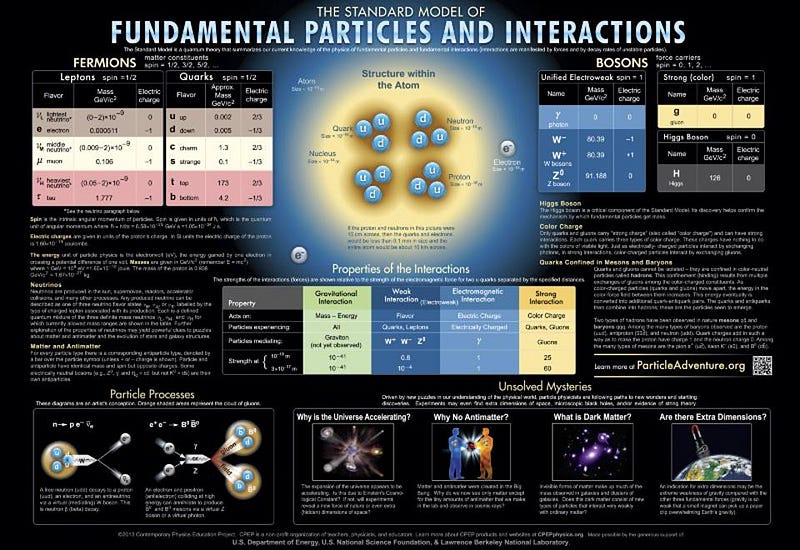
According to the Standard Model, there are three fundamental symmetries that you can “flip” either individually or in some combination:
- C symmetry: this stands for charge conjugation, and instructs you to replace every particle with its antimatter (oppositely charged) counterpart,
- P symmetry: this stands for parity, and instructs you to replace the configuration of your particles with their mirror-image counterpart,
- T symmetry: this stands for time-reversal, and instructs you to reverse the momentum and the order-of-interactions of every particle.
According to the Standard Model, the combination of all three — what we call CPT symmetry — must always be conserved. Searches for CPT violation are always ongoing (and have never been found); if they exist, it would herald a spectacular revolution in physics. But that’s the only mandatory combination that’s always conserved. All other symmetry combinations can be violated, and in the weak interactions in particular, they often are.

Why would you care about whether these individual symmetries are conserved or violated? Because violating these symmetries is a necessary ingredient for creating a Universe that has different amounts of matter and antimatter in it. Back in 1968, Soviet physicist Andrei Sakharov realized that even in a Universe that starts off with equal amounts of matter and antimatter, you can wind up with more matter than antimatter so long as you meet three conditions:
- baryon-violating interactions exist (they do in the Standard Model; through the sphaleron process),
- the Universe is out of thermal equilibrium (it is; this is necessary for an expanding Universe that begins from a hot, dense initial state),
- and there are violations of both C and CP symmetries in large-enough amounts.
The Universe gives us lots of C-violation on its own in the weak interactions, but only very small amounts of CP-violation, at least so far. Moreover, of all the interactions we know of arising from the four fundamental forces, only the weak interactions violate any of these symmetries at all.
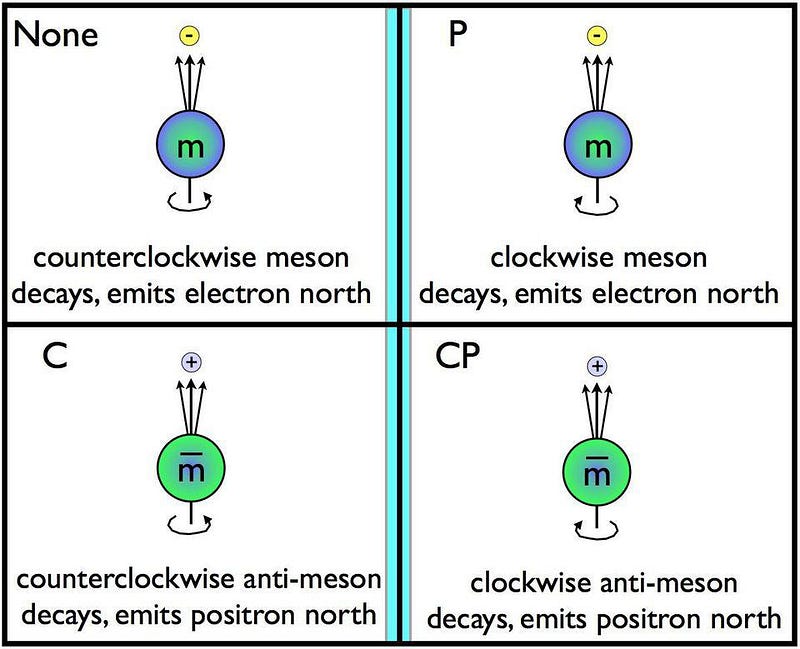
A weak interaction is one, put simply, where the “flavors” (i.e., particle type) of your fermions or anti-fermions change. You might think, with six different “flavor” of quark, that each one could potentially change into any of the five others, yielding a total of 30 possibilities. But in the Standard Model, there are two additional rules that come into play:
- when a quark changes flavor, the “final” quark has to differ in electric charge from the initial one (in physicist-speak, there are no flavor-changing neutral currents),
- and you have to conserve energy, so you can only change a heavier quark into a lighter one.
So if we start with a top quark, it can only decay into a bottom, strange, or down quark. If we start with a bottom quark, it can only decay into a charm or up quark. If we start with a charm quark, it can decay into a strange or down quark. Strange quarks and down quarks can both decay into up quarks, while up quarks (the lightest) cannot decay. All told, there are nine possibilities for quark decays through the weak interaction.

Your quarks will always decay to other quarks; your antiquarks will always decay to other antiquarks. If you have a bottom quark, and sometimes the bottom quark decays into an up quark while other times decaying into a charm quark, you might expect that an anti-bottom quark would decay into an anti-up or anti-charm quark at the same rate. If particles and antiparticles were exactly the same in every way, this would, in fact, be exactly the case.
But that’s not what the Standard Model actually does. The fact that we need CPT symmetry to be conserved tells us that the total rates of bottom quarks decaying must equal the total rates of anti-bottom quarks decaying, but the relative percent of bottom quarks that decay into charm vs. up quarks can be different than the relative percent of anti-bottoms that decay into anti-charm vs. anti-up quarks. That difference is a measure of CP violation in the quark sector.

Unfortunately, we can’t simply take a quark and measure how it decays; isolated quarks don’t stably exist. Quarks all have what’s known as a color-charge, where in addition to electric charges, they have a color: red, green, or blue, while the anti-quarks can be anti-red, anti-green, or anti-blue. To be successfully bound, you need a colorless combination, which can be achieved by color-anticolor combinations or by combining all three colors together. Mesons are a colorless quark-antiquark combination, while baryons are combinations of three quarks. (Antibaryons also exist, as colorless combinations of three antiquarks.)
The most successful experiment ever to look for these subtle differences between how particle combinations decay versus their antiparticle counterparts is LHCb: one of the less famous experiments occurring at the Large Hadron Collider. While the CMS and ATLAS detectors are far more famous — they’re the ones that found the Higgs boson, after all — the LHCb collaboration is focused on studying baryons and mesons that have heavy quarks that can, and do, decay through the weak interactions.
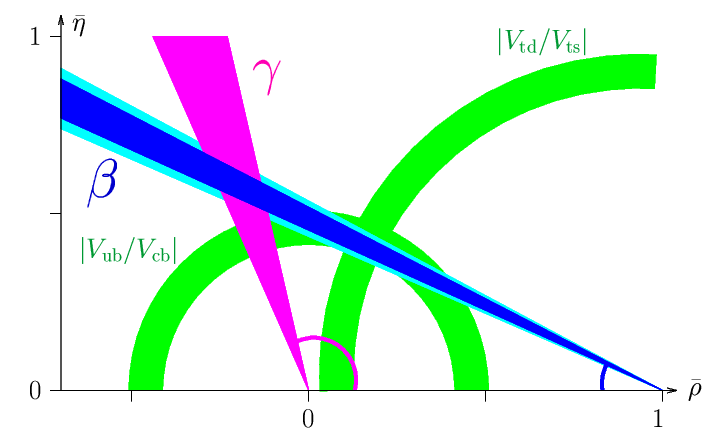
The big tests that enable us to measure CP violation are all about measuring the differences between decays between particles and antiparticles. If you measure all the different ways that charm, bottom, or top quarks decay and compare them to their equally well-measured antiparticle counterparts decay, you wind up with numerous ways of measuring not only CP violation, but how all six quarks experience quantum mixing. In fact, there’s a single mixing matrix — the CKM matrix — that describes the entire process for quarks.
It’s a particularly good test of the Standard Model to make these measurements, because with multiple particles (and antiparticles) decaying in multiple different ways, you could have decay parameters that don’t lead to a consistent picture. There are more possible transitions than there are free parameters, and that’s why doing experiments are so important: your theory makes predictions, but only by experimenting can you test just how good your theory is.

What’s spectacular is that the latest LHCb measurements measure this mixing for bottom vs. anti-bottom quarks in a way that basically eliminates what’s normally the biggest source of uncertainties: the effects of contaminating mesons-and-baryons. By watching how both B+ and B– mesons decay (which are up-antibottom and antiup-bottom combinations, respectively), physicists were able to measure one of these mixing parameters — γ (gamma) — better than ever before: it’s in perfect agreement with every other measurement ever taken, and the Standard Model as well.
We’ve now observed CP violation in mesons that contain strange, charm, and bottom quarks, and have tentative (but not overwhelming) evidence for the first sign of it in baryons as well. Large amounts of statistics and enormous numbers of particle collisions are required to measure these parameters. Through it all, we find the same things: the picture is self-consistent, there’s nothing that disagrees with the Standard Model, and there isn’t enough CP violation to explain the amount of matter we know exists in the Universe.
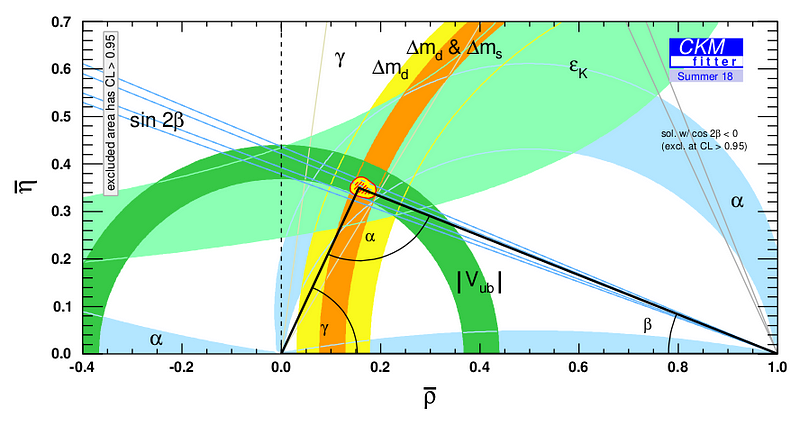
It’s vital, as the LHC currently undergoes its high-luminosity upgrade and the world agonizes over whether to build a new, more powerful collider, to remember what’s at stake. We’re trying to understand the most fundamental components of our Universe: how they behave, what they are, and where they come from. The way we do that is through direct experimental tests. While on the one hand, we know the Universe must have gotten its matter somehow (just as it must’ve gotten its dark matter, somehow), the other hand has yet to reveal exactly where it came from.
The Standard Model continues to be mind-bogglingly successful at predicting what the full suite of these experiments should deliver, but has so far failed to reveal a hint as to how these big mysteries might be resolved. We know the Standard Model can’t be all there is to the Universe, but it works so thoroughly well with each test we throw at it. Each piece of new data we collect is a chance to stumble upon the place where it finally breaks down; an incremental step towards an inevitable revolution. The only question is whether we’ll give up before we get there.
Starts With A Bang is written by Ethan Siegel, Ph.D., author of Beyond The Galaxy, and Treknology: The Science of Star Trek from Tricorders to Warp Drive.





